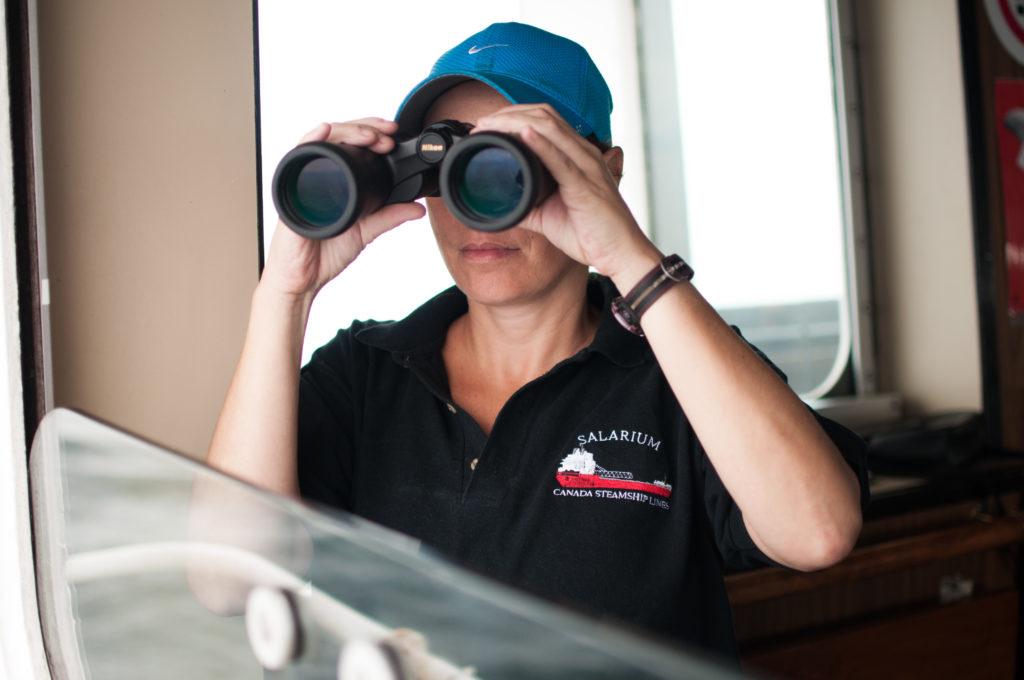
Shipping companies are helping scientists to gather essential data on endangered whales and other cetaceans to better understand and protect the marine mammals. The captains and crews from an increasing number of companies are improving the knowledge base of the Marine Mammal Observation Network (MMON) based in Rivière-du-Loup by reporting whale and other cetacean sightings.
“These efforts are extremely valuable to our scientific understanding of where and when these mammals are in the Gulf of St. Lawrence and coastal Atlantic waters,” says Esther Blier, MMON’s Executive Director. “They extensively broaden our observational resources to provide data that will help to avoid collisions and minimize underwater noise impacts.”
Green Marine, the voluntary environmental certification program for North America’s maritime industry that the Chamber of Marine Commerce helped to establish as a founding association member, has also been involved. The Green Marine staff has facilitated networking and developed the initial training materials with Government of Canada financing through the Habitat Stewardship for Species at Risk program.
“To protect whales, we must first know them,” emphasizes Véronique Nolet, a Green Marine Program Manager and marine biologist who has developed and delivered some of the training. “That’s why it’s so important to raise the level of awareness by directly training crews to identify whales.”
Groupe Desgagnés spearheaded the very first initiative with a single vessel participating in a pilot project with MMON in 1998. Since 2015, the crews aboard the majority of its vessels have been trained in cetacean identification and reporting. They have contributed more than 1,000 observations, including rarely seen black, killer and northern bottlenose whales.
Sightings have slightly declined since 2017 with crews having less time to look for whales. “The efforts necessary to maintain vessel speed at under 10 knots to comply with the mandatory slowdown in the Gulf of St. Lawrence to avoid whale collisions occupies nearly all of a crew’s time,” Daniel Côté, the company’s environmental advisor, explains. “But, of course, the crews will continue to try to do their best.”
This new reality might be offset by other companies increasing their efforts in the relevant waters. Canada Steamship Lines (CSL) also began its whale observations in earnest in 2015 and signed a second three-year agreement with MMON in March 2017. The renewed accord required the company to provide more of its crews transiting the Gulf of St. Lawrence and the Atlantic Coast with the training and resources to identify marine mammals and convey their sightings to MMON.
“Protecting right whales is a top management priority,” says Rhiannah Carver, CSL’s senior management, environment. “CSL is looking to new and innovative technologies that can help us avoid harmful encounters.”

In February 2018, Algoma Central Corporation also signed a three-year agreement with MMON and had the captains and crews from 27 of its relevant carriers learn a few months later how to properly contribute to the data collection.
“Algoma is committed to providing sustainable and environmentally responsible marine transportation,” says Gregg Ruhl, Algoma’s Chief Operating Officer. “Taking part in this conservation initiative and bringing the power of our fleet to gather more data and better understand the whereabouts of marine mammals will support research that can help minimize our environmental impact.”
Many of Algoma’s vessels operate in the Saint Lawrence Estuary, where they may come across beluga, harbour porpoise, minke, blue, fin, and humpback whales. Several vessels also navigate in the Gulf of St. Lawrence and on the Canadian and U.S. East Coast, where they might spot dolphins, pilot whales, and North Atlantic right whales.
Nolet welcomes Algoma’s participation for significantly adding to the observational fleet. “The participation by Algoma’s crews will lead to more reliable data for both the scientific community and the maritime industry operating within these waters,” she says.
Green Marine has served as a liaison between the shipping industry and the scientific community from the outset. “We initiate the first contact and then aim to help different type of vessel operators – international, domestic, pilotage, ferry, tug and so forth – to know what’s required to adhere to MMON’s observation program,” Nolet says.
These efforts are working with several other shipping companies and ferry operators now aboard and others in discussion to join.
“We now have more than 50 vessels involved in the observation/reporting program with other pilot projects in the works,” Blier says.